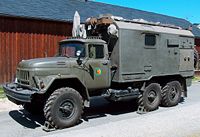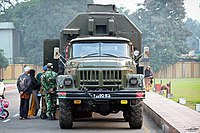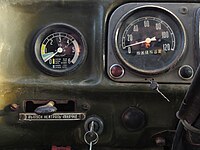
The GAZ-66 is a Soviet and later Russian 4x4 all-road (off-road) military truck produced by GAZ. It was one of the main cargo vehicles for motorized infantry of the Soviet Army and is still employed in former Soviet Union countries. It is nicknamed shishiga (шишига), shisharik (шишарик)/shehsherik (шешерик), trueman.

The GAZ-69 is a four-wheel drive off-road vehicle produced by GAZ between 1953 and 1956 and then by UAZ, in 1956–1972, though all of these light truck class vehicles were known as GAZ-69s. It was also produced in Romania until 1975.

The ZU-23-2, also known as ZU-23, is a Soviet towed 23×152mm anti-aircraft twin-barreled autocannon. ZU stands for Zenitnaya Ustanovka – anti-aircraft mount. The GRAU index is 2A13.

The BM-21 "Grad" is a self-propelled 122 mm multiple rocket launcher designed in the Soviet Union. The system and the M-21OF rocket were first developed in the early 1960s, and saw their first combat use in March 1969 during the Sino-Soviet border conflict. BM stands for boyevaya mashina, and the nickname grad means "hail". The complete system with the BM-21 launch vehicle and the M-21OF rocket is designated as the M-21 field-rocket system. The complete system is more commonly known as a Grad multiple rocket launcher system.

The ZPU is a family of towed anti-aircraft guns based on the Soviet 14.5×114mm KPV heavy machine gun. It entered service with the Soviet Union in 1949 and is used by over 50 countries worldwide.
The Kh-29 is a Soviet air-to-surface missile with a range of 10–30 km. It has a large warhead of 320 kg, has a choice of laser, infrared, active radar or TV guidance, and is typically carried by tactical aircraft such as the Su-24, Su-30, MiG-29K as well as the Su-25, giving these aircraft an expanded standoff capability.
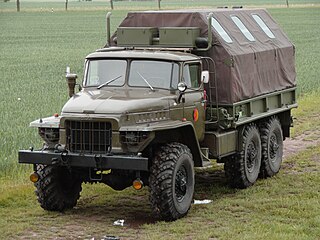
The Ural-375 is a general purpose 4.5 ton 6×6 truck produced at the Ural Automotive Plant in the Russian SFSR from 1961 to 1993. The Ural-375 replaced the ZIL-157 as the standard Soviet Army truck in 1979, and was replaced by the Ural-4320.
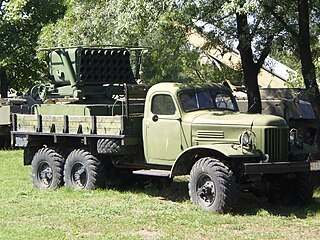
The ZIL-157 is a general-purpose 2+1⁄2-ton 6×6 truck, produced at the Lichachev plant in the Soviet Union from 1958 to 1977, when production was transferred to the Amur plant, since the Lichachev plant wanted to focus more on modern trucks, such as the ZIL-131 range. Nevertheless, production of the ZIL-157 trucks continued even after the fall of the Soviet Union, but eventually ended in 1994.

The 37 mm automatic air defense gun M1939 (61-K) is a Soviet 37 mm calibre anti-aircraft gun developed during the late 1930s and used during World War II. The land-based version was replaced in Soviet service by the AZP S-60 during the 1950s. Guns of this type were successfully used throughout the Eastern Front against dive bombers and other low- and medium-altitude targets. It also had some usefulness against lightly armoured ground targets.

The UAZ-469 is an off-road military light utility vehicle manufactured by UAZ. It was used by Soviet and other Warsaw Pact armed forces, as well as paramilitary units in Eastern Bloc countries. In the Soviet Union, it also saw widespread service in state organizations that needed a robust and durable off-road vehicle. Standard military versions included seating for seven personnel.
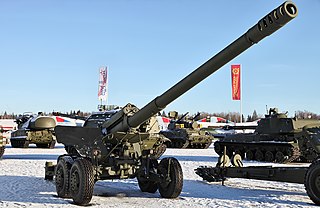
The 2A36 Giatsint-B is a Soviet/Russian towed 152 mm field gun which entered service in 1975. The 2A36 is designed to suppress and destroy enemy manpower and equipment. It is also suitable for counter-battery fire. The gun can be used in various weather conditions and has been tested in temperatures ranging from −50 °C to 50 °C.

The ZIL-E167 is an off-road truck designed in the beginning of the 1960s to withstand difficult conditions in Siberia, Urals and far east and northern territories of the Soviet Union. It could cross water and control its tire pressure, and was equipped with air cleaning systems as well as a 4.5 kW electric engine to pump water. It also had radio transmission capabilities.

The 85-mm divisional gun D-44 was a Soviet divisional 85-mm calibre field artillery gun used in the last action of World War II. It was designed as the replacement for the 76 mm divisional gun M1942 (ZiS-3). The gun was no longer in front-line service with the Russian Ground Forces, until being pressed back into service in the Russo-Ukrainian War in 2023. Wartime service included use by communist forces during the Vietnam War and by Arab forces during their conflicts with Israel.

The UAZ-452 is a family of four wheel drive off-road vans and light trucks with body-on-frame construction and cab over engine design, built by the Ulyanovsk Automobile Plant (UAZ) since 1965. Originally designed for the Soviet military, since 1985 the vans received updates: more modern engines and internationally compliant lighting, as well as new model numbers, UAZ-3741 for the standard van, while (crew-cab) trucks mostly starting with UAZ-3303, often with one or two extra digits specifying the version. From 1997, bigger UAZ-33036 truck variants with a 25 cm (10 in) longer wheelbase, and taller soft-top roof bows and drop-sides were added.
Motor transport (MT) refers to the operation and maintenance of a military vehicle fleet, and sometimes to the servicemembers to operate and maintain them. Traditionally, motor transport organizations are responsible for a unit's military trucks and associated equipment, as well as the transport of personnel and material from one place to another.

The Armed Forces of the Pridnestrovian Moldavian Republic are the military forces of the unrecognized state of Transnistria. The Armed Forces fall under the leadership of the Ministry of Defence. The Armed Forces were created on 6 September 1991 to maintain the sovereignty and independence of the Pridnestrovian Moldavian Republic, in accordance with Article 11 of the Republic's Constitution.

The KrAZ-260 is an off-road truck 6x6 for extreme operations. It was manufactured at the KrAZ plant.

The KrAZ-214 is an off-road truck 6x6 for extreme operations. It was manufactured at the YaMZ plant from 1956-1959, after which production was moved to KrAZ. The model line was the successor to the YaG-10 trucks.

The Novator is a light, multipurpose armored vehicle, designed by the Ukrainian Armor company of Ukraine.


